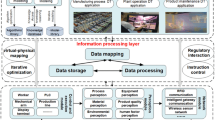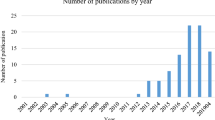Abstract
Computer-aided conceptual design (CACD) aims to increase efficiency and quality of design work but with little essential progress due to the gap between abstract concept and detailed structure. In order to tackle the problem concerned with conceptual design process and automation, this paper introduces the concept of functional surface as the information carrier to link together product function and structure and describes a product genetic model to represent and organize product information. Functional surface is used to formalize the product gene, a varied-length coding scheme for functional surface and product gene is proposed, and the design process model for conceptual design is established based on product gene. Finally, a prototype system for CACD is introduced to demonstrate how a product can be designed based on the proposed model.
Similar content being viewed by others
References
Hsu W, Woon IMY (1998) Current research in the conceptual design of mechanical products. Comput Aided Des 30(5):377–389 doi:10.1016/S0010-4485(97)00101-2
O’Sullivan B (2002) Constraint-aided conceptual design. Wiley, Hoboken
Miles LD (1972) Techniques of value analysis and engineering. McGraw-Hill, New York
Pahl G, Beitz W (1995) Engineering design: a systematic approach, 2nd edn. Springer, London
Chen Y, Feng PE, Lin ZQ (2005) A genetics-based approach for the principle conceptual design of mechanical products. Int J Adv Manuf Technol 27:225–233 doi:10.1007/s00170-004-2164-x
Burr J (1990) A theoretical approach to mechatronics design, PhD thesis. Technical University of Denmark, Lyngby
Umeda Y, Ishii M, Yoshioka M, Shimomura Y, Tomiyama T (1996) Supporting conceptual design based on the function-behavior-state modeler. Artif Intell Eng Des Manuf 10(4):275–288
Qian L, Gero JS (1996) Function-behavior-structure paths and their role in analogy-based design. Artif Intell Eng Des Manuf 10(4):289–312 doi:10.1016/S0954-1810(96)90008-4
Stiny G, Gips J (1978) Algorithmic aesthetics: computer models for criticism and design in the arts. University of California Press, Berkeley
Fitzhorn P (1990) Formal graph languages of shape. Artificial Intel Eng, Design. Anal Manuf 4(3):151–163
Brown KN, McMahon CA, Williams JHS (1994) Constraint unification grammars: Specifying languages of parametric designs. In: Gero JS, Sudweeks F (eds) Artificial Intelligence in Design. Kluwer Academic, Dordrecht, pp 239–256
Andersson K (1993) A vocabulary for conceptual design—part of a design grammar. IFIP WG5.2 Workshop on Formal Design Methods for CAD. Tallinn, pp 139–152
Alberts LK (1993) YMIR: A domain-independent ontology for the formal representation of engineering design knowledge, PhD thesis. University of Twente, Enchede
Ball N, Mattews P, Wallace K (1998) Managing conceptual design objects: An alternative to geometry. In: Gero JS, Sudweeks F (eds) Artificial Intelligence in Design. Kluwer Academic, Dordrecht, pp 67–86
Asimow M (1962) Introduction to design. Prentice-Hall, Englewood Cliffs
Dym C (1994) Engineering design: a synthesis of views. Cambridge University Press, Cambridge
Guan X, MacCallum KJ (1996) Adopting a minimum commitment principle for computer aided geometric design system. In: Gero JS, Sudweeks F (eds) Artificial Intelligence in Design’96. Kluwer Academic, Dordrecht, pp 623–639
van Elsa PA, Vergeest JSM (1998) Displacement feature modeling for conceptual design. Computer-Aided Des 30(1):19–27 doi:10.1016/S0010-4485(97)00049-3
Pabon J, Young R, Keirouz W (1992) Integrating parametric geometry, features and variational modeling for conceptual design. Int J Syst Autom Res App l 2:17–36 SARA.
Potter S, Culley SJ, Darlington MJ, Chawdhry PK (2003) Automatic conceptual design using experience-derived heuristics. Res Eng Des 14:131–144 doi:10.1007/s00163-003-0034-4
Iivonen H, Riitahuhta A (1994) Case-based reasoning in conceptual design. In: Proc. of the Tenth CIM-Europe Annual Conference, Volume 5 of Sharing CIM Solutions. Denmark, pp. 307–314
Shen Z, Smith S (2006) Optimizing the functional design and life cycle cost of mechanical systems using genetic algorithms. Int J Adv Manuf Technol 27:1051–1057 doi:10.1007/s00170-004-2315-0
Gero JS, Shi XG (1999) Design development based on an analogy with developmental biology. In: Gu J, Wei Z (eds) CAADRIA’99. Shanghai Scientific and Technological Literature, Shanghai, pp 253–264
Gero JS (1999) Extensions to evolutionary systems in design from genetic engineering and developmental biology. In: Proc. 1999 Congress on Evolutionary Computation—CEC99, IEEE, Piscataway, New Jersey, pp 474–479
Holland JH (1975) Adaptation in Natural and Artificial Systems. The University of Michigan Press, Ann Arbor
Richard M, Edwin RH (2001) Empirical modeling of the genetic algorithms. Evol Comput 9(4):461–493 doi:10.1162/10636560152642878
Gu XJ, Tan JR, Qi GN (1997) Genetic model for mechanical product information. Chin Mech Eng 8(2):77–79
Chen KZ, Feng XA (2004) Virtual genes of manufacturing products and their reform for product innovative design. Proceedings of the Institution of Mechanical Engineers, Part C. J Mech Eng Sci 218(5):557–574 doi:10.1243/095440704774061219
Parmee IC, Denham MJ (1994) The integration of adaptive search techniques with current engineering design practice. Proc. of Adaptive Computing in Engineering Design and Control’94, Plymouth, 1–13
Pham DT, Yang Y (1993) A genetic algorithm based preliminary design system. J Automobile Engineers. 207(D2):127–133 doi:10.1243/PIME_PROC_1993_207_170_02
Rosenman MA (1997) An exploration into evolutionary models for non-routine design. Artif Intell Eng 11:287–293 doi:10.1016/S0954-1810(96)00046-5
Rosenman MA (1996) A growth model for form generation using a hierarchical evolutionary approach, Microcomputers in Civil engineering. Spec Issue Evol Syst Des 11:161–172
Rosenman MA (1996) The generation of form using an evolutionary approach. In: Gero JS, Sudweeks F (eds) Artificial Intelligence in Design’96. Kluwer Academic, Dordrecht, pp 643–662
Gero JS (2000) Computational models of innovative and creative design process. Technol Forecast Soc Change 64:183–196 doi:10.1016/S0040-1625(99)00105-5
Gero JS, Kazakov VA (1998) Evolving design genes in space layout planning problems. Artif Intell Eng 12(3):163–176 doi:10.1016/S0954-1810(97)00022-8
Huang KZ (1998) Technical report: functional surface decomposition and reconstitution principle and its application. China Hi-Tech Development Program (863). Shandong University of Technology, Jinan
Huang KZ, Wang YD, Yang ZH, Zhang Y, Wang WG, Meng QB, Sun X (2007) Synchronized tolerancing in growth design. Proc. IMechE Part B. J. Eng Manuf 221:1451–1465
Huang KZ (2006) Growth Design Modeling. Proc. of ASME DETC2006/99151, Philadelphia
Yang JY, Huang KZ, Ren HW (2008) Study on PLM-Oriented Product Lifecycle Genetic Model. Int J Manuf Technol Manage 14:201–214 IJMTM doi:10.1504/IJMTM.2008.017495
Kooler R (1990) Mechanical design methodology. Translated by Dang ZL, Tian ST, Tang J et al. Science, Beijing
Huang CY (2000) Mechanical innovative design. Higher Education, Beijing
Huang KZ (2006) Generalized Positioning Principle and Structural Design Automation Theory (in Chinese). http://www.paper.edu.cn/downloadpaper.php?serial_ number=200602-84. Accessed 30 Feb 2006
Huang KZ, Huo ZP, Xu ZG, Li JS, Ai X (1998) Study on schematic design of mechanical product based on decomposition and reconstitution of design requirements. In: Ni J et al (ed) Manufacturing Science and Technology for New Century. Huazhong University of Science and Technology Press, Wuhan, pp 360–364
Author information
Authors and Affiliations
Corresponding author
Rights and permissions
About this article
Cite this article
Shang, Y., Huang, K.Z. & Zhang, Q.P. Genetic model for conceptual design of mechanical products based on functional surface. Int J Adv Manuf Technol 42, 211–221 (2009). https://doi.org/10.1007/s00170-008-1607-1
Received:
Accepted:
Published:
Issue Date:
DOI: https://doi.org/10.1007/s00170-008-1607-1




